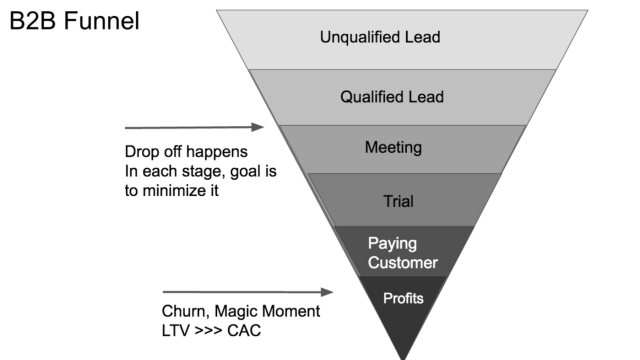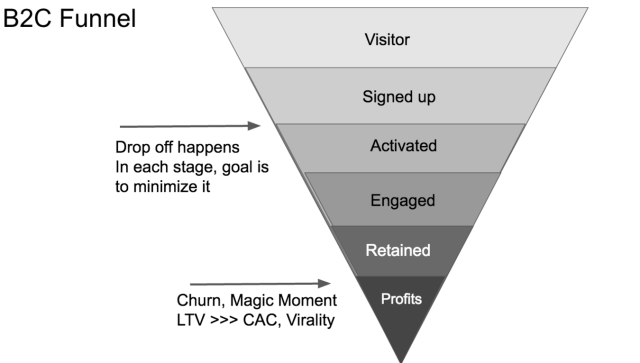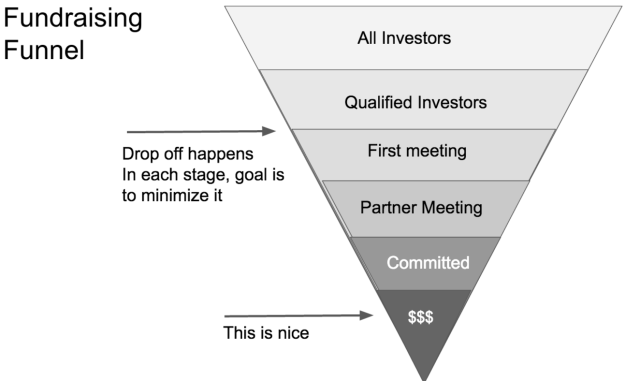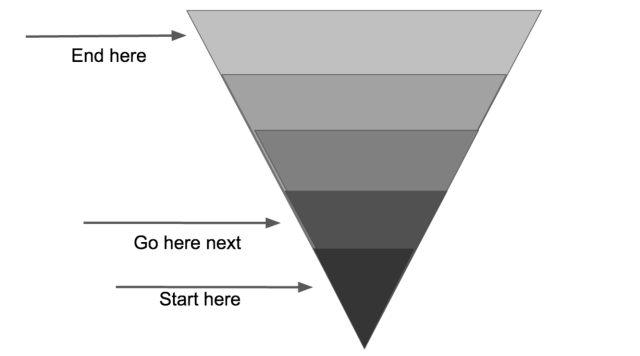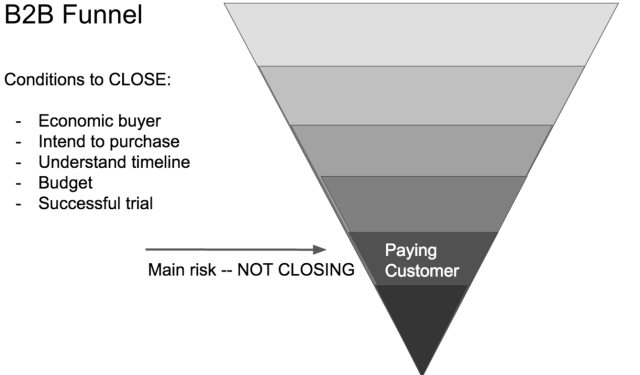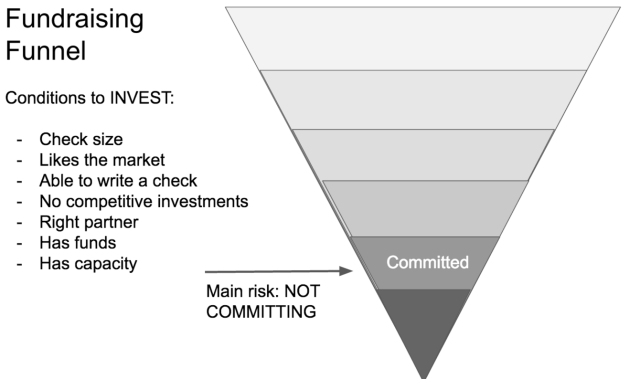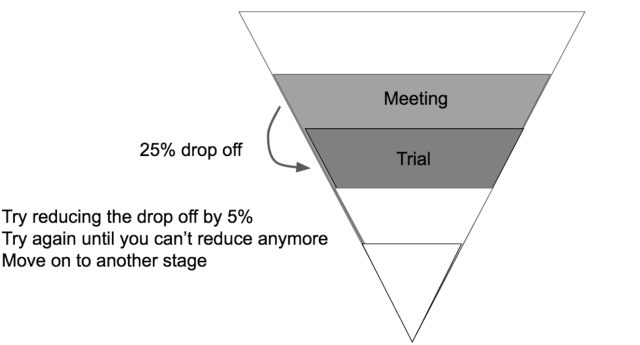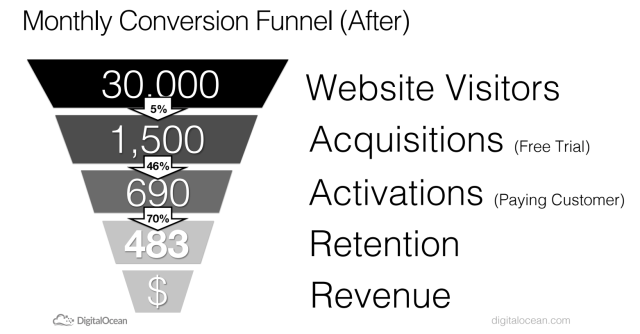Whether you are trying to get users to try your product, sell to an enterprise customer, hire an engineer, or raise capital, you are dealing with a funnel.
Funnels are essentially inverted pyramids divided into stages. The objective is to move through the funnel from top to bottom, while trying to lose as little as possible in each stage.
In other words, a perfect funnel would be: you talked to 100 companies, and every single one became a customer, or you talked to 20 investors and all of them wrote you a check.
Perfect funnels don’t exist in real life—that’s why we are going to talk about strategies and methods to get as close to a perfect funnel as possible.
Rule 1: Optimize Funnels From the Bottom Up
Here is the first and most important rule of any funnel:
Optimize Funnels from the bottom up.
Why? Because it is too costly for you to add leads, potential customers, or investors to the top of the funnel, then spend all your time moving them through the funnel, only to find out in the end that they won’t close.
Picture a massive bucket of water. You keep pouring a ton of water in, but it doesn’t stay in, because there is a hole on the bottom.
Like leaky buckets, funnels that aren’t tuned on the bottom are a waste of your time.
First, you make sure the bottom of the funnel is solid and then you work your way back up through the stages.
For example, if you have a conversion funnel to get people to download your app, but there is a bug in your on-boarding process, then you have a leaky bottom—there’s no point in trying to get more users to come to your site—you need to fix on-boarding first.
In another example, you had 10 customers in late-stage conversations about enterprise sales, but they all said “no.” Why? Apparently, your product doesn’t pass their security requirements.
Or, say you have 2-3 meetings with investors and they keep passing, saying you are too early.
Being able to close is critical, so you want to make sure you really understand what closing would require, and how to optimize the bottom of your funnel.
Rule 2: Understand Conditions to CLOSE
While you can’t be positive that a customer will buy, or an investor will give you a check, you can reduce the risk of not closing by qualifying your leads, actively communicating, and using reflective listening.
Here is a powerful technique: imagine a sale has already happened. Imagine the investor has written you a check. Imagine you have a lot of engaged users actively using your product.
Now ask: what must have happened? What conditions must have been true?
With that in mind, construct a set of questions, a check list, to help you confirm that you are on the right track.
Using sales as an example, make sure you know the economic buyer, and as a decision maker, confirm there is an intent to buy, understand the timeline, budget, criteria for success of a trial, and all other things that need to happen in order for a sale to occur. Ask about the process, but most importantly, fully understand the end game so you can win it.
Similarly, with investors, ask about their process in advance; ask about the check size; whether they invested in competitors; if they intend to make more investments this year; if you are a potential fit; which partner would be working on this, and, what their concerns are and how you can address them.
Rule 3: Tune One Stage of a Funnel at a Time
Once you have spent time optimizing the bottom, and have more confidence about closing, work your way up, one stage at a time.
This is another really important rule—don’t try to optimize across all stages of the funnel at once. Focus on one stage at a time.
Focus on one stage and try to improve the drop-off by a little bit. Set a small goal and hit it. For example in the picture below, try to improve drop-off between the Meeting and Trial stages by 5%. If you succeed in tuning it, do not stop—keep going.
You should focus on tuning the same stage until you can’t tune anymore. Then, move on to the other stages of the funnel and repeat the tuning process.
Below is an example of how Digital Ocean (Techstars ’12) was able to dramatically improve their conversion funnel by tuning one stage at a time.
Tune each stage of the funnel as much as you can, starting from the bottom, and work your way up.
Rule 4: Use Actions and Nudges to Move Through Stages
So how do you actually tune the funnels?
In general, it depends on whether you are working on the product, doing sales, or raising capital.
One common strategy in all of them is a nudge to take an action. A nudge is an explicit ask for a user, customer, or an investor to take an action.
- An action is something a user, customer, or an investor does.
- An action causes movement from one stage of a funnel to another.
- A nudge is something you do to cause the action.
For example, a nudge for a web site could be as simple as copy—”please sign up to get our updates.” Or another similar example of a nudge could be a logo of customers or press articles—”sign up because we are awesome.” In this case, sign up is an action we want a visitor to take. If we succeed, then the user moves to the signed-up stage.
Another kind of nudge would be an email announcing a 50% sale on all sweaters. The expected action is a click, followed by the purchase of a sweater.
Yet another example of a nudge would be informing a VC that you have a term sheet from another VC. The action you are looking for is to get a competing term sheet.
Rule 5: Figure Out Stages of the Funnel
The next thing to understand about funnels is that they are ALL DIFFERENT and have different shapes and stages.
When someone is new to sales, they’ve heard about finding leads, qualifying them, setting up a demo, doing a trial, and then closing.
A generic sales funnel is likely wrong for every single company.
The actual sales funnel has a lot of nuances, and captures the sales process specific to each company, and sometimes, even to each customer. It is fine to start with a generic funnel, but it’s important to quickly recognize where and why it is wrong and tune it.
For example, when you are pitching a venture firm, the process isdifferent for different firms. Some have you meet with associates, one partner, two partners, then ask for diligence; finally, you present at the partner meeting.
Other firms have different processes: meet with an associate, do initial diligence, meet with one partner, do deeper market diligence, then meet with two partners; however, you don’t need to present to full partnership.
If this sounds confusing, it really is, and that’s why it is so important to ask in advance what the process is for each firm.
Activation and Retention Funnel Tips
We will now look at some specific tips that apply to different types of funnels.
If you are running a B2C business, you need to master Activation and Retention. Activation typically includes getting a visitor to sign up and explore the product. Retention is focused on bringing t users back and making sure they continue to use the product.
Activation:
- What does the user do right after they sign up?
- What do they do in the first 5 minutes, first day, first week?
- What is the hook that will get them to come back?
- What are the key nudges?
Retention:
- When and why would the user come back?
- What are the key nudges?
- What do you expect the user to do?
- How often do you expect the user to come back?
B2C Churn and Magic Moment Tips
Churn occurs when a user stops using your product. Since it typically costs money for most businesses to acquire users at scale, businesses with high churn aren’t viable.
Magic Moment is a state such that, if a user hits this state, there is high likelihood that the user will remain a user in the future and won’t churn.
More precisely, if Magic Moment is reached by N users, then for this group of users, and each such group, the Life Time Value – Cost of Acquisition equation results in a viable business.
For example, Facebook discovered that once a new user added 20 friends they would stay. The reason was that friends would generate content that would help pull back the new user. Facebook benefited from discovering their Magic Moment early on and tapped into massive network effects.
To sum up, Magic Moment helps us create a viable business. We have covered Magic Moment in depth in a separate post.
Sales Funnel Tips
Sales are the bread and butter of B2B and are pretty well understood. When you are starting a new company, you don’t know in advance what YOUR sales funnel will look like. Once you become a real business, you will have a lot of predictability and control over your sales by mastering and optimizing your sales funnel.
Here are some important things to consider with your sales funnels early on:
Qualify Leads: Come up with a checklist to qualify your leads. Disqualify quickly.
Define your funnel: Guess the stages of your funnel. Make your funnel specific and unique. Iterate as you learn more about your customers. If you are struggling or have big drop off, you may need to add a stage / nudge.
Use reflective listening: Ask about the process in the beginning, and confirm your understanding at every stage and during every meeting.
Create predictability: As you optimize your funnel you should be able to get better and better at forecasting.
Kevin O’Brien, sales veteran and CEO of GreatHorn, adds these specific tips:
- Establish your target persona; building the top of your funnel, typically what marketing will provide into a sales organization, requires that you clearly understand the title, role, responsibilities, and challenges facing your buyer.
- 67% of the buying process happens This is often mis-cited as: “before sales speaks to a prospect”—don’t fall into this trap. Instead, generate strong content that maps to your target persona’s needs, incorporate strong metrics and tracking into your site, and follow-up when a potential buyer is engaged. Filling the top of your funnel with website visitors for whom you have no follow-up strategy won’t generate business.
- Have a clear progression that aligns with how your target buys what you offer. At GreatHorn, ours is designed around simplicity: Discovery -> Qualification -> Proof of Concept/Trial -> Procurement -> Close. A common mistake is to have far too many stages in your sales process; ideally, your funnel stages should mirror the buyer’s experience of learning who you are, what you do, and how you can help them.
- Mercilessly track your conversion percentages between stages. How many website leads become discovery calls? How many start trials? Are you converting 20% of trials to close, or 80%? You can optimize a sales funnel in two basic ways: by generating more top-of-funnel activity at your current conversion rates, or by improving conversion at the middle- or bottom-of-funnel stages.
- Get out of Excel. Your marketing stack and sales CRM should be tightly integrated, enable automation and metrics, and should generate actionable stats easily. If you need more than 2 minutes to determine your total funnel, forecast, or strongest content pieces, invest time and resources into better tools—technology doesn’t sell for you, but it’s one of the few things you can directly control that can blockyou if done poorly.
B2B Churn and Magic Moment Tips
B2B churn happens when a customer cancels or doesn’t renew contract.
B2B businesses with a lot of churn typically have Cost of Acquisition > Lifetime Value and are not viable.
Magic Moment in the B2B world isn’t a sale, it is usage of the product.
Products that aren’t used eventually churn all of their users. The customer success function in the B2B world is tasked with ensuring high satisfaction and low churn, but of course the product needs to be awesome to begin with.
Pay close attention to customer satisfaction, renewal, and churn. Even costlier than not closing the sale is to close the sale of a product that won’t be used. Use analytics to obsessively track usage of your product, and use nudges to help customers get the most out of it.
Investor Funnels Tips
We’ve written a lot of posts here on the topic of fundraising. To succeed, the founders need to prepare, execute on the business, get in front of the right investors, and walk through the investor funnel.
Here are some key things to consider:
Setup your investor funnel: Create a spreadsheet or use another tracking system to set up your investor funnel. We covered this process in detail in this post.
Pre-qualify each investor: Before engaging, figure out if this investor is right for you. Are they interested in your space? Are they actively investing? Have they funded a competitor? Is their check size appropriate for your stage? Do they have bandwidth? Make sure you are clear about all of this in advance. Here are the questions you should be thinking about.
Understand the process: Ask investors about their process. Ask during each meeting what the rest of the process is like from here. This allows you to keep track and keep refining your funnel.
Use reflective listening: Use reflective listening to confirm that you understand what’s being said. Avoid happy ears. Accept a NO, don’t accept a MAYBE.
Understand how to commit: Commit investors and understand conditions for each commit. Read this post on how to commit investors with confidence.
Funnels are really important in all aspects of startup life. There is a lot more to them, but hopefully this post is a good starting point for you.
And now, please share tips and tricks that worked well for YOUR funnels.


